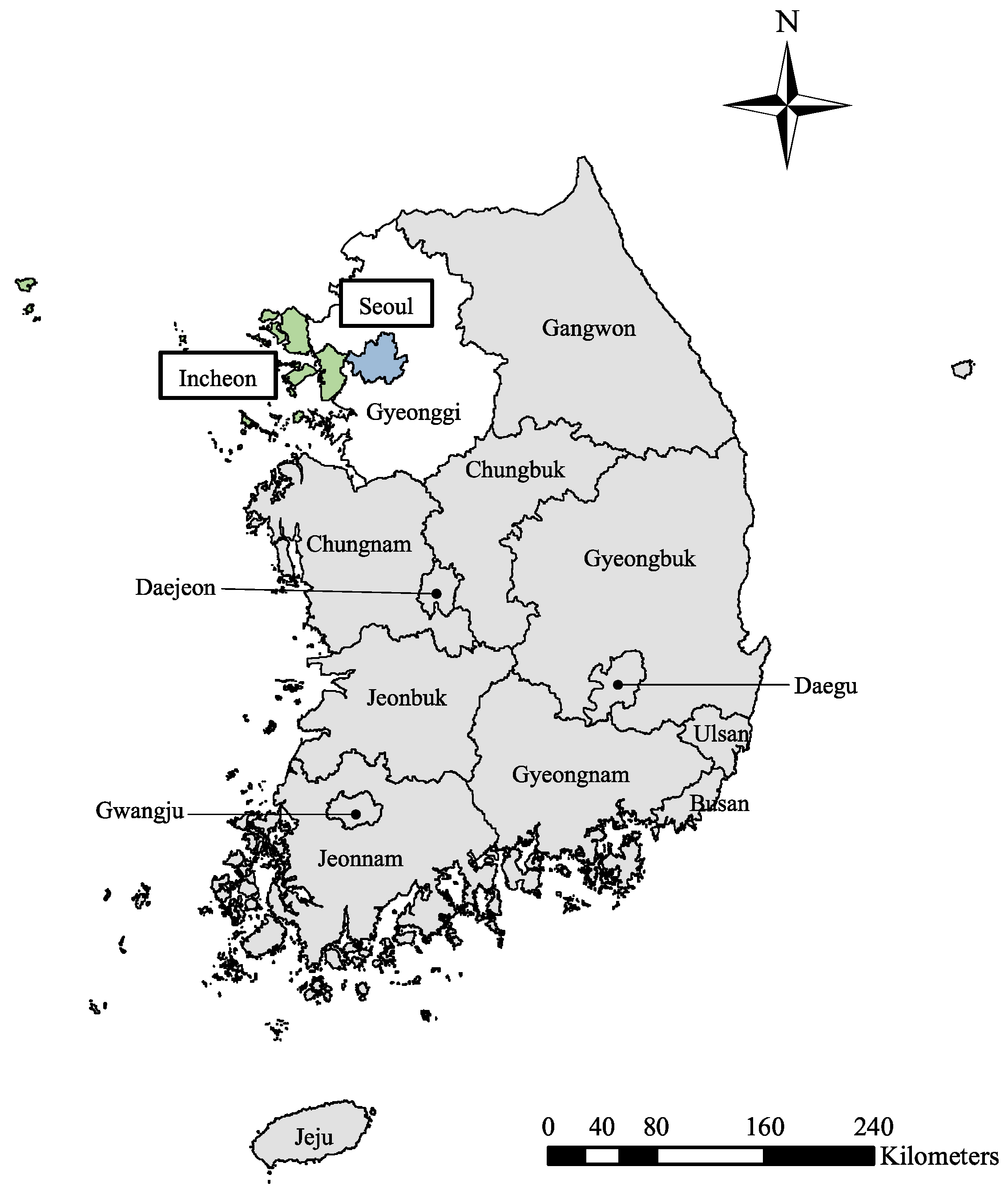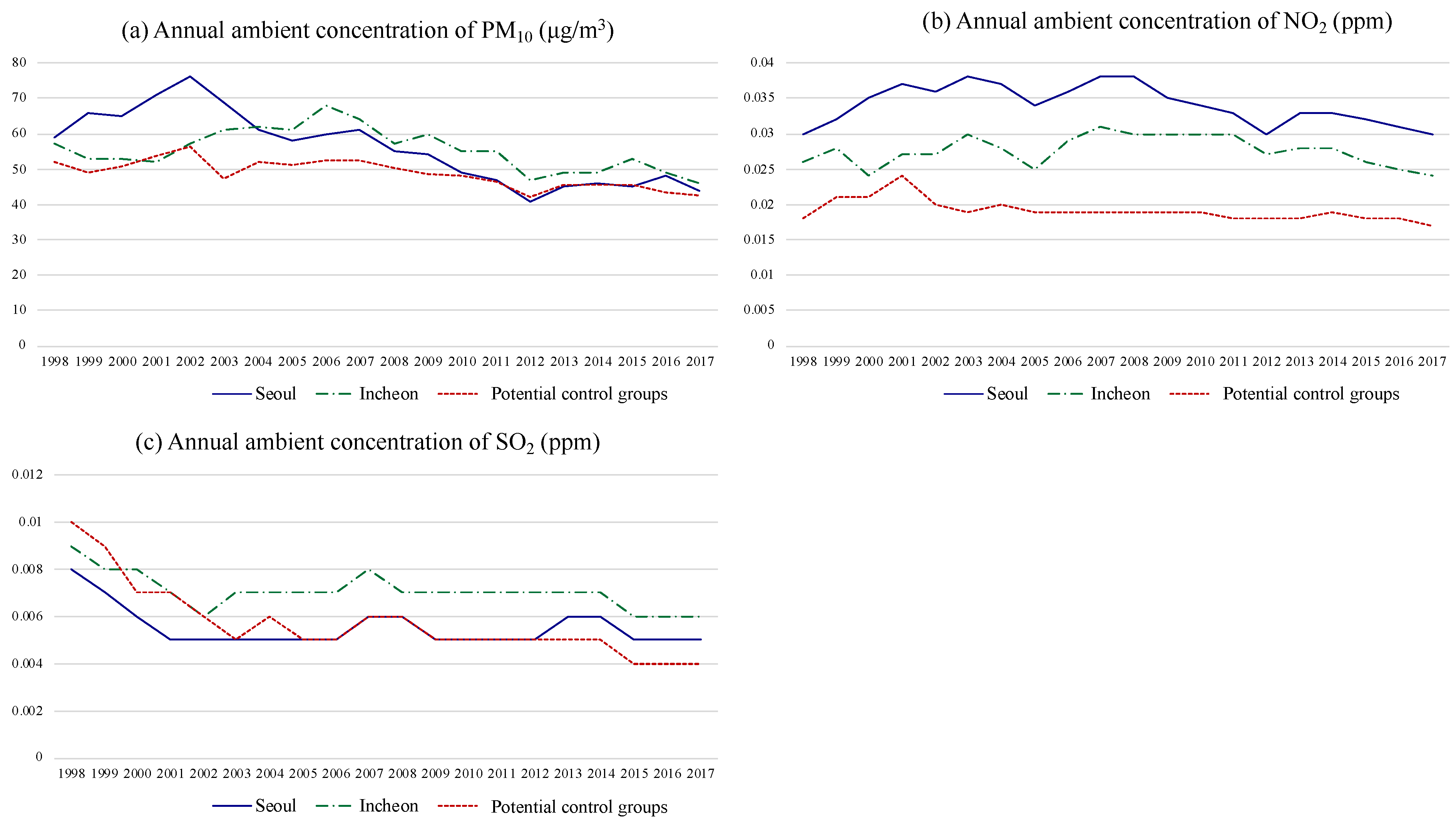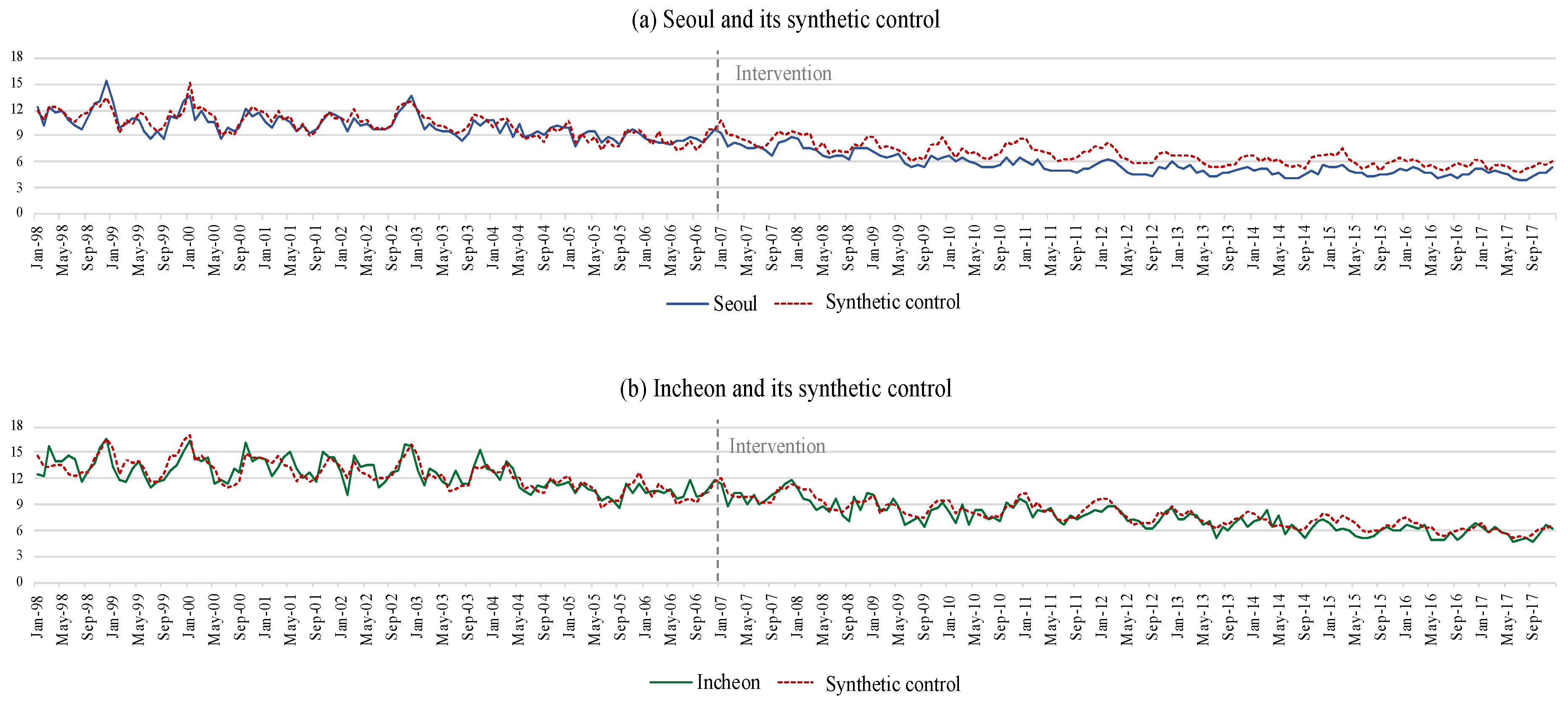Health Effects of Air-Quality Regulations in Seoul Metropolitan Area: Applying Synthetic Control Method to Controlled-Interrupted Time-Series Analysis
Abstract
:1. Introduction
2. Materials and Methods
2.1. Intervention and Study Population
2.2. Data
2.3. Statistical Analysis
2.3.1. Descriptive Analysis of Air Quality
2.3.2. Synthetic Control Method
2.3.3. Controlled-Interrupted Time-Series Analysis
2.3.4. Sensitivity Analysis
3. Results
3.1. Descriptive Results of Air Quality
3.2. Synthetic Controls
3.3. Controlled-Interrupted Time-Series Analysis
4. Discussion
5. Conclusions
Supplementary Materials
Author Contributions
Funding
Conflicts of Interest
References
- Pope, C.A.; Dockery, D.W.; Schwartz, J. Review of epidemiological evidence of health effects of particulate air pollution. Inhal. Toxicol. 1995, 7, 1–18. [Google Scholar] [CrossRef]
- Samet, J.M.; Zeger, S.L.; Dominici, F.; Curriero, F.; Coursac, I.; Dockery, D.W.; Schwartz, J.; Zanobetti, A. The national morbidity, mortality, and air pollution study. Res. Rep. Health Eff. Inst. 2000, 94, 5–79. [Google Scholar] [PubMed]
- Guxens, M.; Sunyer, J. A review of epidemiological studies on neuropsychological effects of air pollution. Swiss Med. Wkly. 2012, 141. [Google Scholar] [CrossRef]
- Gupta, A.; Gautam, S.; Mehta, N.; Patel, M.K.; Talatiya, A. Association between changes in air quality and hospital admissions during the holi festival. SN Appl. Sci. 2019, 1, 163. [Google Scholar] [CrossRef] [Green Version]
- Bell, M.L.; Morgenstern, R.D.; Harrington, W. Quantifying the human health benefits of air pollution policies: Review of recent studies and new directions in accountability research. Environ. Sci. Policy 2011, 14, 357–368. [Google Scholar] [CrossRef]
- Boogaard, H.; van Erp, A.M.; Walker, K.D.; Shaikh, R. Accountability studies on air pollution and health: The HEI experience. Curr. Environ. Health Rep. 2017, 4, 514–522. [Google Scholar] [CrossRef]
- Korea National Assembly Budget Office. Analysis of Projects to Respond Particulate Matter Problems (Engl. Tansl.); Korea National Assembly Budget Office: Seoul, Korea, 2019; ISBN 9788960732063.
- Han, C.; Lim, Y.H.; Yorifuji, T.; Hong, Y.C. Air quality management policy and reduced mortality rates in Seoul Metropolitan Area: A quasi–experimental study. Environ. Int. 2018, 121, 600–609. [Google Scholar] [CrossRef]
- Kim, H.; Kim, H.; Lee, J.T. Effect of air pollutant emission reduction policies on hospital visits for asthma in Seoul, Korea; Quasi–experimental study. Environ. Int. 2019, 132, 104954. [Google Scholar] [CrossRef]
- McNamee, R. Confounding and confounders. Occup. Environ. Med. 2003, 60, 227–234. [Google Scholar] [CrossRef] [Green Version]
- Bottomley, C.; Scott, J.A.G.; Isham, V. Analysing interrupted time series with a control. Epidemiol. Methods 2019. [Google Scholar] [CrossRef]
- Abadie, A.; Diamond, A.; Hainmueller, J. Synthetic control methods for comparative case studies: Estimating the effect of California’s tobacco control program. J. Am. Stat. Assoc. 2010, 105, 493–505. [Google Scholar] [CrossRef] [Green Version]
- Abadie, A.; Diamond, A.; Hainmueller, J. Comparative politics and the synthetic control method. Am. J. Political Sci. 2015, 59, 495–510. [Google Scholar] [CrossRef]
- Korea Ministry of Environment. Basic Plans for Second Phase of Air Quality Improvement Plan for Seoul Metropolitan Areas (2015–2024) (Engl. Transl.); Korea Ministry of Environment: Sejong, Korea, 2013. Available online: http://www.me.go.kr/home/web/policy_data/read.do;jsessionid=TRvS5alq5YRi8393qi8cVubySPy87FyI48o94lc11DdqFsIGQRAKdTCpxPaFagcT.meweb1vhost_servlet_engine1?pagerOffset=550&maxPageItems=10&maxIndexPages=10&searchKey=&searchValue=&menuId=10259&orgCd=&seq=6482 (accessed on 20 July 2020).
- Jee, S.H.; Yun, J.E.; Park, J.Y.; Sull, J.W.; Kim, I.S. Smoking and cause of death in Korea: 11 years follow–up prospective study. Korean J. Epidemiol. 2005, 27, 182–190. [Google Scholar]
- Jung, K.J.; Yun, Y.D.; Baek, S.J.; Jee, S.H.; Kim, I.S. Smoking–attributable mortality among Korean adults, 2012. J. Korea Soc. Health Inform. Stat. 2013, 38, 36–48. [Google Scholar]
- Bascom, R.; Bromberg, P.A.; Costa, D.L.; Devlin, R.; Dockery, D.W.; Frampton, M.W.; Lambert, W.; Samet, J.M.; Speizer, F.E.; Utell, M. Health effects of outdoor air pollution. Am. J. Respir. Crit. Care Med. 1996, 153, 477–498. [Google Scholar]
- Son, J.Y.; Lee, J.T.; Kim, H.; Yi, O.; Bell, M.L. Susceptibility to air pollution effects on mortality in Seoul, Korea: A case–crossover analysis of individual–level effect modifiers. J. Expo. Sci. Environ. Epidemiol. 2012, 22, 227–234. [Google Scholar] [CrossRef] [Green Version]
- Son, J.Y.; Bell, M.L. The relationships between short–term exposure to particulate matter and mortality in Korea: Impact of particulate matter exposure metrics for sub–daily exposures. Environ. Res. Lett. 2013, 8, 014015. [Google Scholar] [CrossRef]
- Park, J.K.; Jung, W.S.; Kim, E.B. A study on the influence of extreme heat on daily mortality. J. Korean Soc. Atmos. Environ. 2008, 24, 523–537. [Google Scholar] [CrossRef] [Green Version]
- Ha, J.; Yoon, J.; Kim, H. Relationship between winter temperature and mortality in Seoul, South Korea, from 1994 to 2006. Sci. Total Environ. 2009, 407, 2158–2164. [Google Scholar] [CrossRef]
- Basu, R. High ambient temperature and mortality: A review of epidemiologic studies from 2001 to 2008. Environ. Health 2009, 8, 40. [Google Scholar] [CrossRef] [Green Version]
- Simonsen, L. The global impact of influenza on morbidity and mortality. Vaccine 1999, 17, S3–S10. [Google Scholar] [CrossRef]
- Park, M.; Wu, P.; Goldstein, E.; Kim, W.J.; Cowling, B.J. Influenza–associated excess mortality in South Korea. Am. J. Prev. Med. 2016, 50, e111–e119. [Google Scholar] [CrossRef] [PubMed] [Green Version]
- Nguyen, J.L.; Yang, W.; Ito, K.; Matte, T.D.; Shaman, J.; Kinney, P.L. Seasonal influenza infections and cardiovascular disease mortality. JAMA Cardiol. 2016, 1, 274–281. [Google Scholar] [CrossRef] [PubMed] [Green Version]
- Brenner, M.H. Influence of health care expenditures, GDP, employment and globalization on cardiovascular disease mortality: Potential implications for the current recession. Int. J. Bus. Soc. Sci. 2012, 3, 1–10. [Google Scholar]
- Chi, T.K.; Kwag, K.H.; Jekarl, J.; Park, M.S.; Kim, K.K. An ecological study on factors associated with community mortality rates. Korean J. Health Educ. Promot. 2015, 32, 11–22. [Google Scholar] [CrossRef] [Green Version]
- Seo, S.H.; Jung, Y.W.; Kim, Y.T. Avoidable Mortality in Korea, 2000–2014. Public Health Wkly. Rep. 2016, 9, 98–107. [Google Scholar]
- Chang, I.; Kim, B.H. Regional disparity of medical resources and its effect on age–standardized mortality rates in Korea. Ann. Reg. Sci. 2019, 62, 305–325. [Google Scholar] [CrossRef]
- Abadie, A.; Diamond, A.; Hainmueller, J. Synth: An r package for synthetic control methods in comparative case studies. J. Stat. Softw. 2011, 42, 1–17. [Google Scholar] [CrossRef] [Green Version]
- Chelwa, G.; van Walbeek, C.; Blecher, E. Evaluating South Africa’s tobacco control policy using a synthetic control method. Tob. Control 2017, 26, 509–517. [Google Scholar] [CrossRef]
- Yorifuji, T.; Kashima, S. Fine–particulate air pollution from diesel emission control and mortality rates in Tokyo. Epidemiology 2016, 27, 769–778. [Google Scholar] [CrossRef]
- Han, H.; Jung, C.; Kim, H.; Kim, Y. The revisit of the PM10 reduction policy in Korea: Focusing on policy target, tools and effect of first air quality management plan in Seoul Metropolitan Area. J. Korea Environ. Policy Adm. 2017, 25, 49–79. [Google Scholar] [CrossRef]
- Korea Ministry of Environment. Research for Evaluating Policies in Air Quality Control Region and Planning Improvement Methods (Engl. Transl.); Korea Ministry of Environment: Sejong, Korea, 2015. Available online: http://www.prism.go.kr/homepage/entire/retrieveEntireDetail.do;jsessionid=4AF3A77BD02306A812F8AEF419D495CA.node02?cond_research_name=&cond_research_start_date=&cond_research_end_date=&research_id=1480000–201500138&pageIndex=727&leftMenuLevel=160 (accessed on 20 July 2020).
- Hoek, G.; Krishnan, R.M.; Beelen, R.; Peters, A.; Ostro, B.; Brunekreef, B.; Kaufman, J.D. Long–term air pollution exposure and cardio–respiratory mortality: A review. Environ. Health 2013, 12, 43. [Google Scholar] [CrossRef] [PubMed] [Green Version]
- Kim, Y.P. Analysis of the trend of atmospheric PM10 concentration over the Seoul Metropolitan Area between 1999 and 2008. J. Environ. Impact Assess. 2010, 19, 59–74. [Google Scholar]
- Kim, K.H.; Shon, Z.H. Long-term changes in PM10 levels in urban air in relation with air quality control efforts. Atmos. Environ. 2011, 45, 3309–3317. [Google Scholar] [CrossRef]
- Clancy, L.; Goodman, P.; Sinclair, H.; Dockery, D.W. Effect of air–pollution control on death rates in Dublin, Ireland: An intervention study. Lancet 2002, 360, 1210–1214. [Google Scholar] [CrossRef]
- Hedley, A.J.; Wong, C.M.; Thach, T.Q.; Ma, S.; Lam, T.H.; Anderson, H.R. Cardiorespiratory and all–cause mortality after restrictions on sulphur content of fuel in Hong Kong: An intervention study. Lancet 2002, 360, 1646–1652. [Google Scholar] [CrossRef]
- Pope III, C.A.; Rodermund, D.L.; Gee, M.M. Mortality effects of a copper smelter strike and reduced ambient sulfate particulate matter air pollution. Environ. Health Perspect. 2007, 115, 679–683. [Google Scholar] [CrossRef] [Green Version]
- Henschel, S.; Atkinson, R.; Zeka, A.; Le Tertre, A.; Analitis, A.; Katsouyanni, K.; Chanel, O.; Pascal, M.; Forsberg, B.; Medina, S. Air pollution interventions and their impact on public health. Int. J. Public Health 2012, 57, 757–768. [Google Scholar] [CrossRef]
- Lin, H.; Zhang, Y.; Liu, T.; Xiao, J.; Xu, Y.; Xu, X.; Qian, Z.; Tong, S.; Luo, Y.; Zeng, W. Mortality reduction following the air pollution control measures during the 2010 Asian Games. Atmos. Environ. 2014, 91, 24–31. [Google Scholar] [CrossRef]
- Lin, H.; Liu, T.; Fang, F.; Xiao, J.; Zeng, W.; Li, X.; Guo, L.; Tian, L.; Schootman, M.; Stamatakis, K.A. Mortality benefits of vigorous air quality improvement interventions during the periods of APEC Blue and Parade Blue in Beijing, China. Environ. Pollut. 2017, 220, 222–227. [Google Scholar] [CrossRef] [Green Version]
- Henneman, L.R.; Choirat, C.; Zigler, C.M. Accountability assessment of health improvements in the United States associated with reduced coal emissions between 2005 and 2012. Epidemiology 2019, 30, 477–485. [Google Scholar] [CrossRef] [PubMed]
- Hong, Y.C.; Lee, J.T.; Kim, H.; Ha, E.H.; Schwartz, J.; Christiani, D.C. Effects of air pollutants on acute stroke mortality. Environ. Health Perspect. 2002, 110, 187–191. [Google Scholar] [CrossRef] [PubMed]
- Son, J.Y.; Lee, J.T.; Kim, K.H.; Jung, K.; Bell, M.L. Characterization of fine particulate matter and associations between particulate chemical constituents and mortality in Seoul, Korea. Environ. Health Perspect. 2012, 120, 872–878. [Google Scholar] [CrossRef] [PubMed] [Green Version]
- Han, S.H.; Kim, Y.P. Long–term Trends of the Concentrations of Mass and Chemical Composition in PM 2.5 over Seoul. J. Korean Soc. Atmos. Environ. 2015, 31, 143–156. [Google Scholar] [CrossRef] [Green Version]
- Jun, T.; Min, I.S. Air pollution, respiratory illness and behavioral adaptation: Evidence from South Korea. PLoS ONE 2019, 14, e0221098. [Google Scholar] [CrossRef] [PubMed] [Green Version]
- Sills, E.O.; Herrera, D.; Kirkpatrick, A.J.; Brandão Jr, A.; Dickson, R.; Hall, S.; Pattanayak, S.; Shoch, D.; Vedoveto, M.; Young, L. Estimating the impacts of local policy innovation: The synthetic control method applied to tropical deforestation. PLoS ONE 2015, 10, e0132590. [Google Scholar] [CrossRef] [PubMed] [Green Version]
- Xu, Y. Generalized synthetic control method: Causal inference with interactive fixed effects models. Political Anal. 2017, 25, 57–76. [Google Scholar] [CrossRef] [Green Version]
- World Health Organization. WHO Country Cooperation Strategy 2019–2023: Republic of Korea; World Health Organization. Regional Office for the Western Pacific: Manila, Philippines, 2019; Available online: https://iris.wpro.who.int/bitstream/handle/10665.1/14327/WPRO–2019–DPM–001–kor–eng.pdf (accessed on 20 July 2020).
- Kim, D.; Lee, S.; Ki, M.; Kim, M.; Kim, S.S.; Kim, Y.; Yun, T.; Jang, S.; Chae, H.; Lee, J.A. Developing Health Inequalities Indicators and Monitoring the Status of Health Inequalities in Korea; Korea Institute for Health and Social Affairs: Sejong, Korea, 2013. [Google Scholar]
- Jang, S.; Lee, J.; Kim, C.; Heo, H.; Hwang, J.; Kim, T. Developing key indicators of health equity and strategies for reducing health disparity in National Health Plan. Korean Soc. Health Educ. Promot. 2017, 34, 41–57. [Google Scholar] [CrossRef]
- Korea Institute for Health and Social Affairs. Research for Development of First Comprehensive Management Plan for Cardio–and Cerebrovascular Diseases (2018~2022) (Engl. Transl.); Korea Institute for Health and Social Affairs: Sejong, Korea, 2017. Available online: http://www.prism.go.kr/homepage/entire/retrieveEntireDetail.do;jsessionid=4C7A1083DC3143158E2A765E72F2BB2F.node02?cond_research_name=&cond_research_start_date=&cond_research_end_date=&research_id=1351000–201800003&pageIndex=137&leftMenuLevel=160 (accessed on 20 July 2020).
- Kim, W.H.L.; Eun, K.; Kim, D.H.; Kim, Y. Impact of Coverage Expansion on Fiscal Sustainability of Healthcare System in Korea: On Four Major Disease; Institute of Public Finance: Sejong, Korea, 2018; Available online: https://www.kipf.re.kr/gafsc/Publication/publication_Report/kiPublish/CA/view.do?serialNo=526299# (accessed on 20 July 2020).
- Gunter, R.; Szeto, E.; Jeong, S.H.; Suh, S.A.; Waters, A.J. Cigarette Smoking in South Korea: A Narrative Review. Korean J. Fam. Med. 2020, 41, 3. [Google Scholar] [CrossRef] [Green Version]
- Davis, R.E.; Kalkstein, L.S. Using a spatial synoptic climatological classification to assess changes in atmospheric pollution concentrations. Phys. Geogr. 1990, 11, 320–342. [Google Scholar] [CrossRef]
- gon Ryou, H.; Heo, J.; Kim, S.Y. Source apportionment of PM10 and PM2. 5 air pollution, and possible impacts of study characteristics in South Korea. Environ. Pollut. 2018, 240, 963–972. [Google Scholar] [CrossRef] [PubMed]
- Park, I.S.; Kim, H.K.; Song, C.K.; Jang, Y.W.; Kim, S.H.; Cho, C.R.; Owen, J.S.; Kim, C.H.; Chung, K.W.; Park, M.S. Meteorological characteristics and assessment of the effect of local emissions during high PM10 concentration in the Seoul Metropolitan Area. Asian J. Atmos. Environ. 2019, 13, 117–135. [Google Scholar] [CrossRef]
- Kim, E.; Kim, H.; Kim, B.; Kim, S. PM2. 5 Simulations for the Seoul Metropolitan Area:(VI) Estimating Influence of Sectoral Emissions from Chungcheongnamdo. J. Korean Soc. Atmos. Environ. 2019, 35, 226–248. [Google Scholar] [CrossRef]
- Yeo, M.J.; Kim, Y.P. Trends of the PM10 Concentrations and High PM10 Concentration Cases in Korea. J. Korean Soc. Atmos. Environ. 2019, 35, 249–264. [Google Scholar] [CrossRef]
- Linden, A. Combining synthetic controls and interrupted time series analysis to improve causal inference in program evaluation. J. Eval. Clin. Pract. 2018, 24, 447–453. [Google Scholar] [CrossRef]
- Lopez Bernal, J.; Cummins, S.; Gasparrini, A. The use of controls in interrupted time series studies of public health interventions. Int. J. Epidemiol. 2018, 47, 2082–2093. [Google Scholar] [CrossRef] [Green Version]
- Pieters, H.; Curzi, D.; Olper, A.; Swinnen, J. Effect of democratic reforms on child mortality: A synthetic control analysis. Lancet Glob. Health 2016, 4, e627–e632. [Google Scholar] [CrossRef] [Green Version]
- Bruhn, C.A.; Hetterich, S.; Schuck–Paim, C.; Kürüm, E.; Taylor, R.J.; Lustig, R.; Shapiro, E.D.; Warren, J.L.; Simonsen, L.; Weinberger, D.M. Estimating the population–level impact of vaccines using synthetic controls. Proc. Natl. Acad. Sci. USA 2017, 114, 1524–1529. [Google Scholar] [CrossRef] [Green Version]
- Olper, A.; Curzi, D.; Swinnen, J. Trade liberalization and child mortality: A synthetic control method. World Dev. 2018, 110, 394–410. [Google Scholar] [CrossRef]



| Area | Pre-Intervention Period | Post-Intervention Period | ||
|---|---|---|---|---|
| Mean | Total | Mean | Total | |
| Seoul | 10.19 | 1101.01 | 5.63 | 743.65 |
| Synthetic control of Seoul | 10.36 | 1118.38 | 6.79 | 896.64 |
| Incheon | 12.48 | 134 7.58 | 7.46 | 985.31 |
| Synthetic control of Incheon | 12.48 | 1347.55 | 7.84 | 1034.35 |
| Seoul | Incheon | |||
|---|---|---|---|---|
| Synthetic Control | Daejeon | Synthetic Control | Daejeon | |
| Cardiovascular Mortality Rate | 0.07 | 0.14 | 0.08 | 0.18 |
| Smoking rate | 0.07 | 0.06 | 0.05 | 0.10 |
| PM10 concentration | 0.25 | 0.29 | 0.17 | 0.23 |
| Temperature | 0.08 | 0.05 | 0.13 | 0.08 |
| Pneumonia mortality rate | 0.38 | 0.60 | 0.34 | 0.49 |
| Gross regional domestic product (GRDP) | 0.88 | 0.91 | 0.06 | 0.51 |
| % of urban population | 0.11 | 0.00 | 0.04 | 0.03 |
| Avoidable mortality rate | 0.16 | 0.15 | 0.06 | 0.14 |
| Mean | 0.25 | 0.28 | 0.12 | 0.22 |
| Seoul | Incheon | |
|---|---|---|
| Coefficient (95% CI) | Coefficient (95% CI) | |
| β0 (Intercept) | −9.0387 (−9.0691, −9.0083) b | −8.8282 (−8.8618, −8.7946) a |
| β1 (Time trend) | −0.0006 (−0.001, −0.0003) b | 0 (−0.0004, 0.0003) a |
| β2 (Slope change) | −0.001 (−0.0015, −0.0004) b | −0.0006 (−0.0012, 0) a |
© 2020 by the authors. Licensee MDPI, Basel, Switzerland. This article is an open access article distributed under the terms and conditions of the Creative Commons Attribution (CC BY) license (http://creativecommons.org/licenses/by/4.0/).
Share and Cite
Kim, S.-Y.; Kim, H.; Lee, J.-T. Health Effects of Air-Quality Regulations in Seoul Metropolitan Area: Applying Synthetic Control Method to Controlled-Interrupted Time-Series Analysis. Atmosphere 2020, 11, 868. https://doi.org/10.3390/atmos11080868
Kim S-Y, Kim H, Lee J-T. Health Effects of Air-Quality Regulations in Seoul Metropolitan Area: Applying Synthetic Control Method to Controlled-Interrupted Time-Series Analysis. Atmosphere. 2020; 11(8):868. https://doi.org/10.3390/atmos11080868
Chicago/Turabian StyleKim, Soo-Yeon, Hyomi Kim, and Jong-Tae Lee. 2020. "Health Effects of Air-Quality Regulations in Seoul Metropolitan Area: Applying Synthetic Control Method to Controlled-Interrupted Time-Series Analysis" Atmosphere 11, no. 8: 868. https://doi.org/10.3390/atmos11080868
APA StyleKim, S.-Y., Kim, H., & Lee, J.-T. (2020). Health Effects of Air-Quality Regulations in Seoul Metropolitan Area: Applying Synthetic Control Method to Controlled-Interrupted Time-Series Analysis. Atmosphere, 11(8), 868. https://doi.org/10.3390/atmos11080868





